Hongming Xu
Multi-modal Knowledge Decomposition based Online Distillation for Biomarker Prediction in Breast Cancer Histopathology
Aug 24, 2025Abstract:Immunohistochemical (IHC) biomarker prediction benefits from multi-modal data fusion analysis. However, the simultaneous acquisition of multi-modal data, such as genomic and pathological information, is often challenging due to cost or technical limitations. To address this challenge, we propose an online distillation approach based on Multi-modal Knowledge Decomposition (MKD) to enhance IHC biomarker prediction in haematoxylin and eosin (H\&E) stained histopathology images. This method leverages paired genomic-pathology data during training while enabling inference using either pathology slides alone or both modalities. Two teacher and one student models are developed to extract modality-specific and modality-general features by minimizing the MKD loss. To maintain the internal structural relationships between samples, Similarity-preserving Knowledge Distillation (SKD) is applied. Additionally, Collaborative Learning for Online Distillation (CLOD) facilitates mutual learning between teacher and student models, encouraging diverse and complementary learning dynamics. Experiments on the TCGA-BRCA and in-house QHSU datasets demonstrate that our approach achieves superior performance in IHC biomarker prediction using uni-modal data. Our code is available at https://github.com/qiyuanzz/MICCAI2025_MKD.
Towards Efficient Deep Spiking Neural Networks Construction with Spiking Activity based Pruning
Jun 03, 2024



Abstract:The emergence of deep and large-scale spiking neural networks (SNNs) exhibiting high performance across diverse complex datasets has led to a need for compressing network models due to the presence of a significant number of redundant structural units, aiming to more effectively leverage their low-power consumption and biological interpretability advantages. Currently, most model compression techniques for SNNs are based on unstructured pruning of individual connections, which requires specific hardware support. Hence, we propose a structured pruning approach based on the activity levels of convolutional kernels named Spiking Channel Activity-based (SCA) network pruning framework. Inspired by synaptic plasticity mechanisms, our method dynamically adjusts the network's structure by pruning and regenerating convolutional kernels during training, enhancing the model's adaptation to the current target task. While maintaining model performance, this approach refines the network architecture, ultimately reducing computational load and accelerating the inference process. This indicates that structured dynamic sparse learning methods can better facilitate the application of deep SNNs in low-power and high-efficiency scenarios.
INSIGHT: End-to-End Neuro-Symbolic Visual Reinforcement Learning with Language Explanations
Mar 19, 2024Abstract:Neuro-symbolic reinforcement learning (NS-RL) has emerged as a promising paradigm for explainable decision-making, characterized by the interpretability of symbolic policies. For tasks with visual observations, NS-RL entails structured representations for states, but previous algorithms are unable to refine the structured states with reward signals due to a lack of efficiency. Accessibility is also an issue, as extensive domain knowledge is required to interpret current symbolic policies. In this paper, we present a framework that is capable of learning structured states and symbolic policies simultaneously, whose key idea is to overcome the efficiency bottleneck by distilling vision foundation models into a scalable perception module. Moreover, we design a pipeline that uses large language models to generate concise and readable language explanations for policies and decisions. In experiments on nine Atari tasks, our approach demonstrates substantial performance gains over existing NSRL methods. We also showcase explanations for policies and decisions.
Multi-Agent Reinforcement Learning for Connected and Automated Vehicles Control: Recent Advancements and Future Prospects
Dec 18, 2023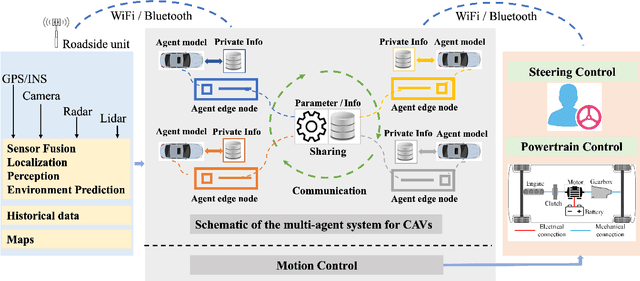
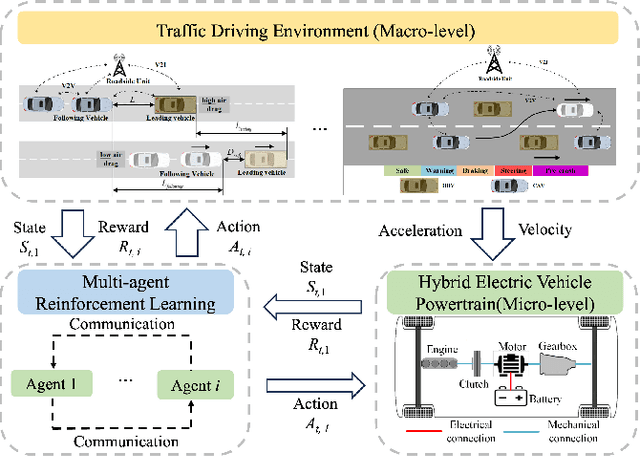
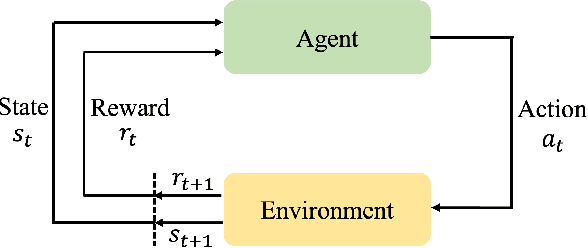
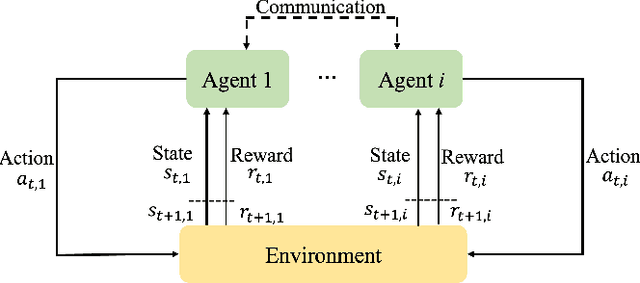
Abstract:Connected and automated vehicles (CAVs) have emerged as a potential solution to the future challenges of developing safe, efficient, and eco-friendly transportation systems. However, CAV control presents significant challenges, given the complexity of interconnectivity and coordination required among the vehicles. To address this, multi-agent reinforcement learning (MARL), with its notable advancements in addressing complex problems in autonomous driving, robotics, and human-vehicle interaction, has emerged as a promising tool for enhancing the capabilities of CAVs. However, there is a notable absence of current reviews on the state-of-the-art MARL algorithms in the context of CAVs. Therefore, this paper delivers a comprehensive review of the application of MARL techniques within the field of CAV control. The paper begins by introducing MARL, followed by a detailed explanation of its unique advantages in addressing complex mobility and traffic scenarios that involve multiple agents. It then presents a comprehensive survey of MARL applications on the extent of control dimensions for CAVs, covering critical and typical scenarios such as platooning control, lane-changing, and unsignalized intersections. In addition, the paper provides a comprehensive review of the prominent simulation platforms used to create reliable environments for training in MARL. Lastly, the paper examines the current challenges associated with deploying MARL within CAV control and outlines potential solutions that can effectively overcome these issues. Through this review, the study highlights the tremendous potential of MARL to enhance the performance and collaboration of CAV control in terms of safety, travel efficiency, and economy.
Recent Progress in Energy Management of Connected Hybrid Electric Vehicles Using Reinforcement Learning
Aug 28, 2023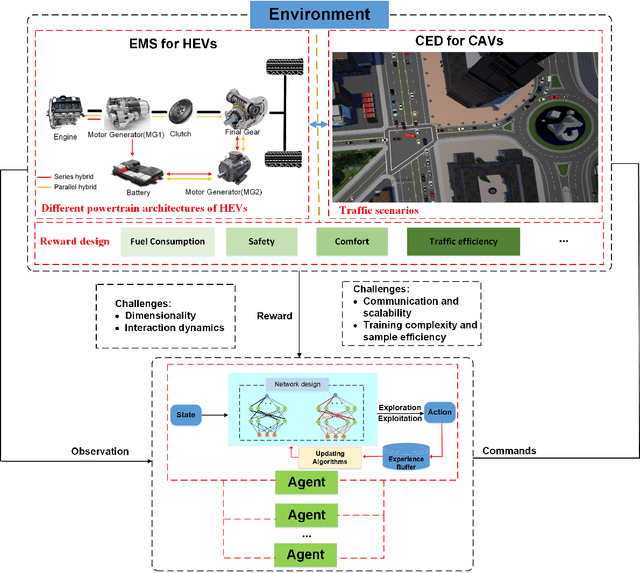

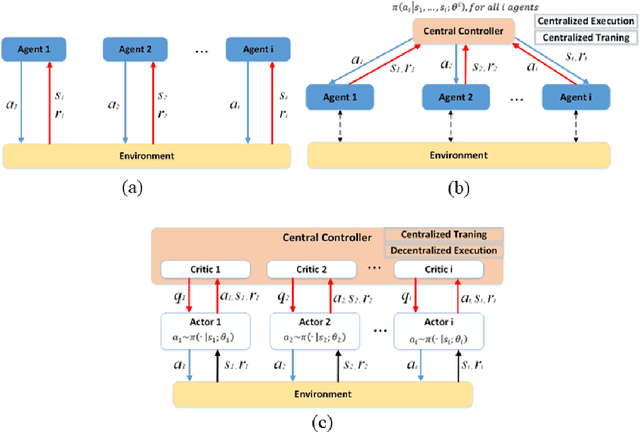
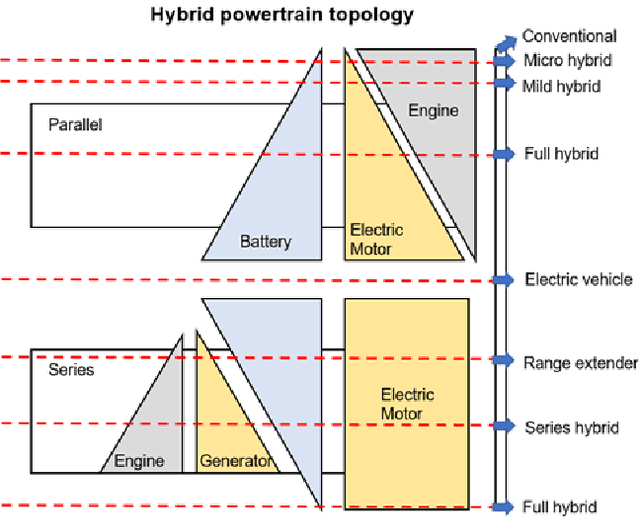
Abstract:The growing adoption of hybrid electric vehicles (HEVs) presents a transformative opportunity for revolutionizing transportation energy systems. The shift towards electrifying transportation aims to curb environmental concerns related to fossil fuel consumption. This necessitates efficient energy management systems (EMS) to optimize energy efficiency. The evolution of EMS from HEVs to connected hybrid electric vehicles (CHEVs) represent a pivotal shift. For HEVs, EMS now confronts the intricate energy cooperation requirements of CHEVs, necessitating advanced algorithms for route optimization, charging coordination, and load distribution. Challenges persist in both domains, including optimal energy utilization for HEVs, and cooperative eco-driving control (CED) for CHEVs across diverse vehicle types. Reinforcement learning (RL) stands out as a promising tool for addressing these challenges at hand. Specifically, within the realm of CHEVs, the application of multi-agent reinforcement learning (MARL) emerges as a powerful approach for effectively tackling the intricacies of CED control. Despite extensive research, few reviews span from individual vehicles to multi-vehicle scenarios. This review bridges the gap, highlighting challenges, advancements, and potential contributions of RL-based solutions for future sustainable transportation systems.
Study on the Impacts of Hazardous Behaviors on Autonomous Vehicle Collision Rates Based on Humanoid Scenario Generation in CARLA
Jul 15, 2023



Abstract:Testing of function safety and Safety Of The Intended Functionality (SOTIF) is important for autonomous vehicles (AVs). It is hard to test the AV's hazard response in the real world because it would involve hazards to passengers and other road users. This paper studied on virtual testing of AV on the CARLA platform and proposed a Humanoid Scenario Generation (HSG) scheme to investigate the impacts of hazardous behaviors on AV collision rates. The HSG scheme breakthrough the current limitation on the rarity and reproducibility of real scenes. By accurately capturing five prominent human driver behaviors that directly contribute to vehicle collisions in the real world, the methodology significantly enhances the realism and diversity of the simulation, as evidenced by collision rate statistics across various traffic scenarios. Thus, the modular framework allows for customization, and its seamless integration within the CARLA platform ensures compatibility with existing tools. Ultimately, the comparison results demonstrate that all vehicles that exhibited hazardous behaviors followed the predefined random speed distribution and the effectiveness of the HSG was validated by the distinct characteristics displayed by these behaviors.
Energy Management of Multi-mode Plug-in Hybrid Electric Vehicle using Multi-agent Deep Reinforcement Learning
Mar 16, 2023



Abstract:The recently emerging multi-mode plug-in hybrid electric vehicle (PHEV) technology is one of the pathways making contributions to decarbonization, and its energy management requires multiple-input and multiple-output (MIMO) control. At the present, the existing methods usually decouple the MIMO control into single-output (MISO) control and can only achieve its local optimal performance. To optimize the multi-mode vehicle globally, this paper studies a MIMO control method for energy management of the multi-mode PHEV based on multi-agent deep reinforcement learning (MADRL). By introducing a relevance ratio, a hand-shaking strategy is proposed to enable two learning agents to work collaboratively under the MADRL framework using the deep deterministic policy gradient (DDPG) algorithm. Unified settings for the DDPG agents are obtained through a sensitivity analysis of the influencing factors to the learning performance. The optimal working mode for the hand-shaking strategy is attained through a parametric study on the relevance ratio. The advantage of the proposed energy management method is demonstrated on a software-in-the-loop testing platform. The result of the study indiates that learning rate of the DDPG agents is the greatest factor in learning performance. Using the unified DDPG settings and a relevance ratio of 0.2, the proposed MADRL method can save up to 4% energy compared to the single-agent method.
Optimal Energy Management of Plug-in Hybrid Vehicles Through Exploration-to-Exploitation Ratio Control in Ensemble Reinforcement Learning
Mar 15, 2023Abstract:Developing intelligent energy management systems with high adaptability and superiority is necessary and significant for Hybrid Electric Vehicles (HEVs). This paper proposed an ensemble learning-based scheme based on a learning automata module (LAM) to enhance vehicle energy efficiency. Two parallel base learners following two exploration-to-exploitation ratios (E2E) methods are used to generate an optimal solution, and the final action is jointly determined by the LAM using three ensemble methods. 'Reciprocal function-based decay' (RBD) and 'Step-based decay' (SBD) are proposed respectively to generate E2E ratio trajectories based on conventional Exponential decay (EXD) functions of reinforcement learning. Furthermore, considering the different performances of three decay functions, an optimal combination with the RBD, SBD, and EXD is employed to determine the ultimate action. Experiments are carried out in software-in-loop (SiL) and hardware-in-the-loop (HiL) to validate the potential performance of energy-saving under four predefined cycles. The SiL test demonstrates that the ensemble learning system with an optimal combination can achieve 1.09$\%$ higher vehicle energy efficiency than a single Q-learning strategy with the EXD function. In the HiL test, the ensemble learning system with an optimal combination can save more than 1.04$\%$ in the predefined real-world driving condition than the single Q-learning scheme based on the EXD function.
Multi-agent Deep Reinforcement Learning for Charge-sustaining Control of Multi-mode Hybrid Vehicles
Sep 06, 2022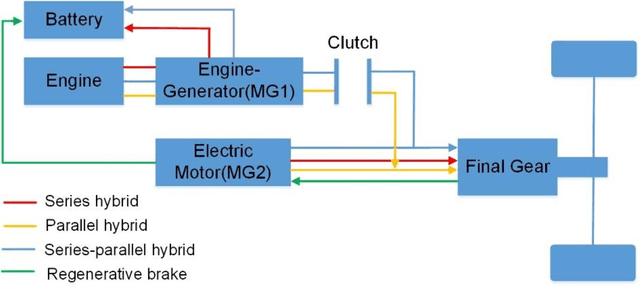
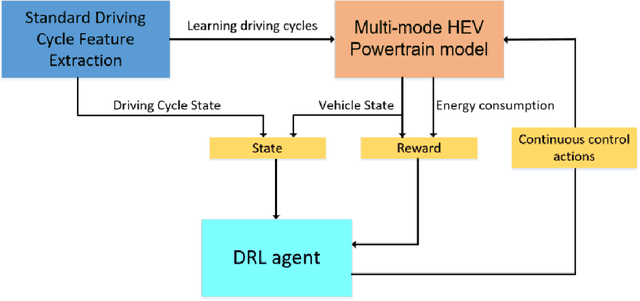
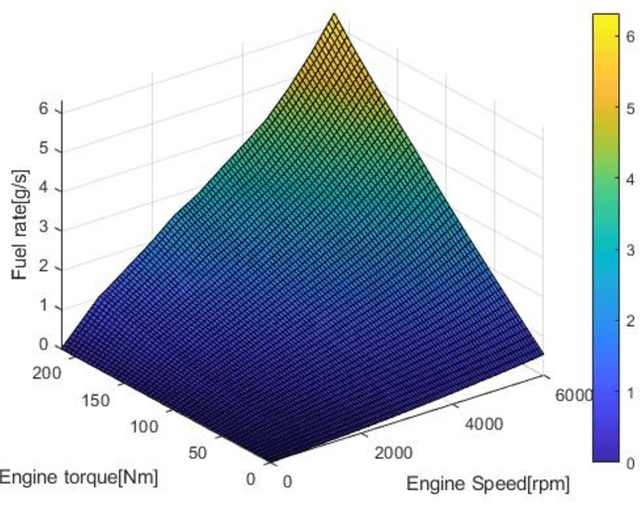
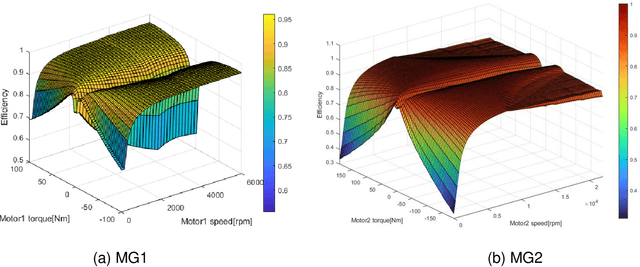
Abstract:Transportation electrification requires an increasing number of electric components (e.g., electric motors and electric energy storage systems) on vehicles, and control of the electric powertrains usually involves multiple inputs and multiple outputs (MIMO). This paper focused on the online optimization of energy management strategy for a multi-mode hybrid electric vehicle based on multi-agent reinforcement learning (MARL) algorithms that aim to address MIMO control optimization while most existing methods only deal with single output control. A new collaborative cyber-physical learning with multi-agents is proposed based on the analysis of the evolution of energy efficiency of the multi-mode hybrid electric vehicle (HEV) optimized by a deep deterministic policy gradient (DDPG)-based MARL algorithm. Then a learning driving cycle is set by a novel random method to speed up the training process. Eventually, network design, learning rate, and policy noise are incorporated in the sensibility analysis and the DDPG-based algorithm parameters are determined, and the learning performance with the different relationships of multi-agents is studied and demonstrates that the not completely independent relationship with Ratio 0.2 is the best. The compassion study with the single-agent and multi-agent suggests that the multi-agent can achieve approximately 4% improvement of total energy over the single-agent scheme. Therefore, the multi-objective control by MARL can achieve good optimization effects and application efficiency.
Automatic Skin Lesion Segmentation Using Deep Fully Convolutional Networks
Jul 17, 2018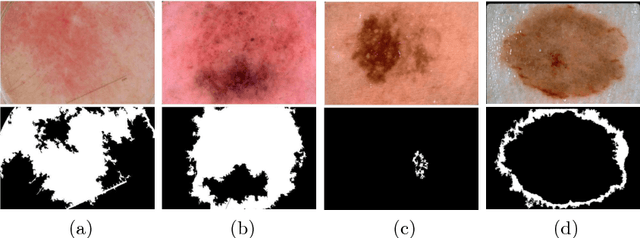

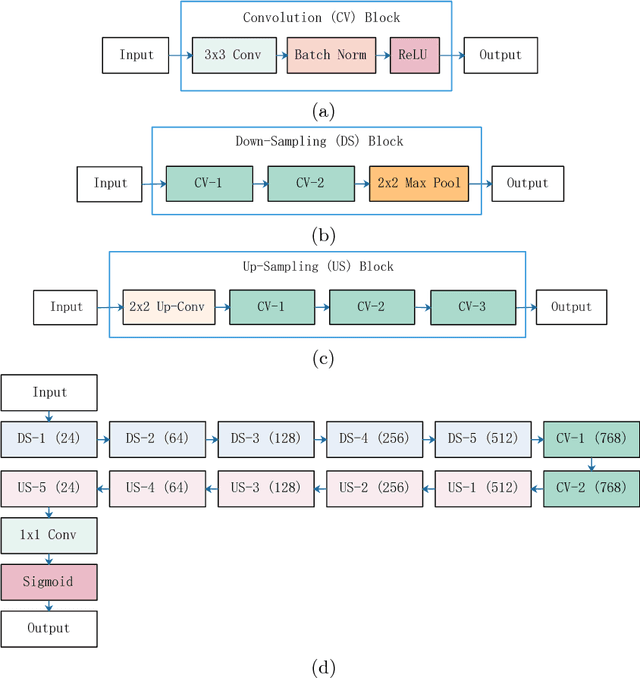
Abstract:This paper summarizes our method and validation results for the ISIC Challenge 2018 - Skin Lesion Analysis Towards Melanoma Detection - Task 1: Lesion Segmentation
 Add to Chrome
Add to Chrome Add to Firefox
Add to Firefox Add to Edge
Add to Edge